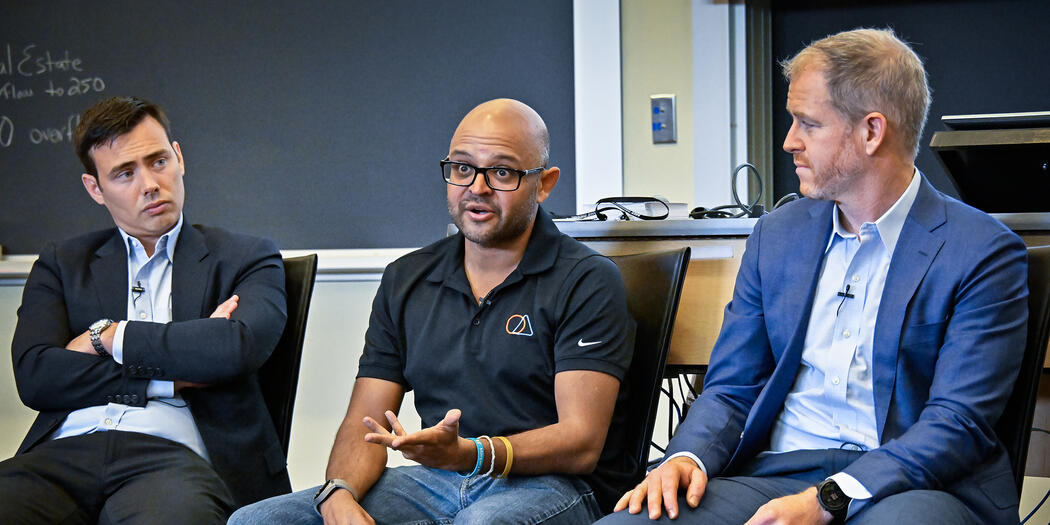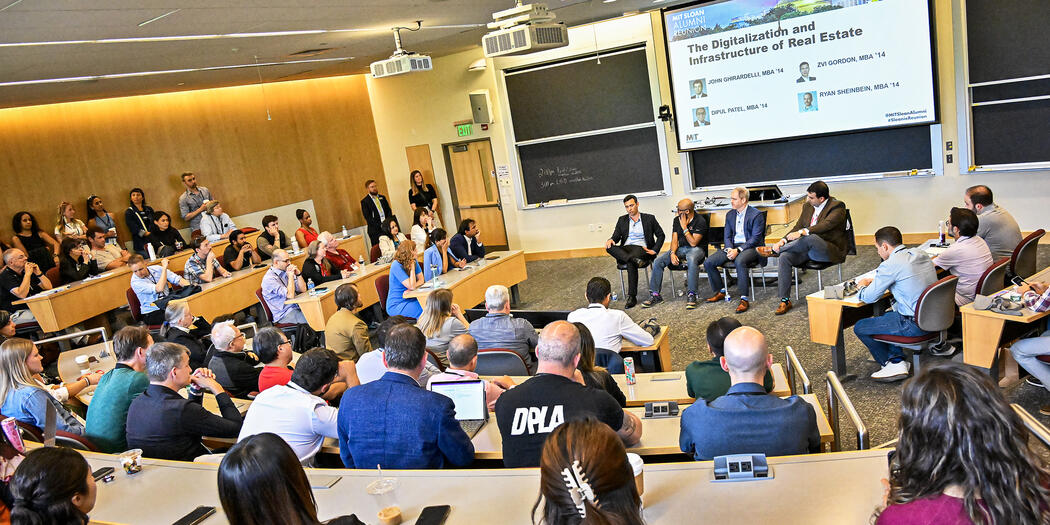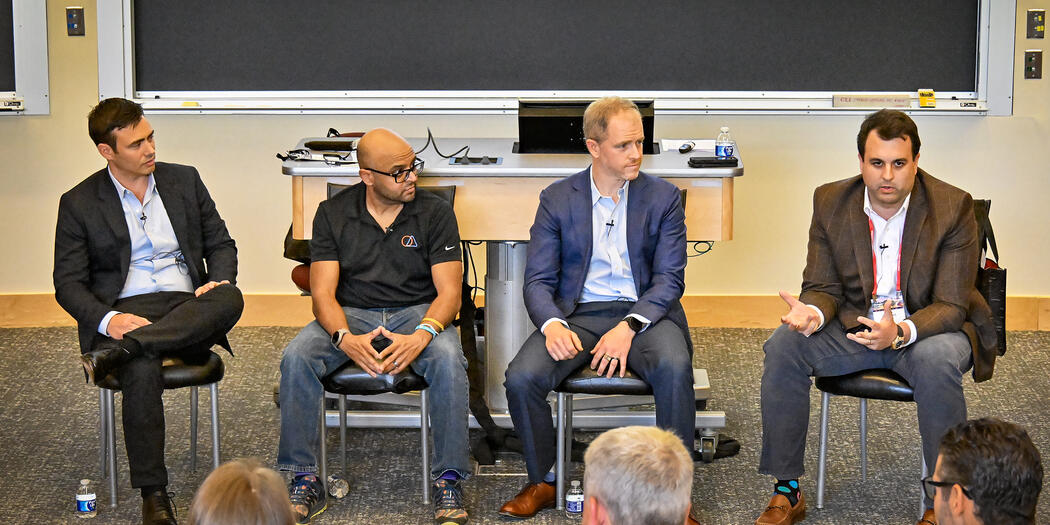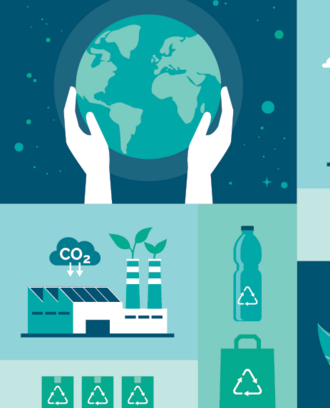The energy needs of our world are growing exponentially. Real estate, both residential and business, is already a massive consumer of that energy and has recently seen a huge uptick in power needs. In particular, technological innovations that include large language models and generative AI like ChatGPT require power, water, and electricity at levels previously unforeseen. This has had cascading infrastructural impacts—especially since data centers, which use this energy, have had to adapt to these changing needs.
“The load on the US grid has been constant for the past 40 years up until today. We were building data centers that were one megawatt, 10 megawatts. Now, they’re 100 megawatts, 500 megawatts, and one gigawatt. Now, you’re putting all this stress on the grid,” said John Ghirardelli, MBA ’14, executive director at Morgan Stanley Infrastructure Partners.
On May 31, 2024, Ghirardelli moderated a panel titled “The Digitalization and Infrastructure of Real Estate” at MIT Sloan Reunion 2024, in which experts discussed the challenges—and opportunities—for anyone working in this space.
Zvi Gordon, MBA ’14, Dipul Patel, MBA ’14, and Ryan Sheinbein, MBA ’14, discuss data centers and wind farms at MIT Sloan Reunion 2024.
Credit: L. Barry Hetherington
The complexities of delivering ever more power
Data centers need to deliver content quickly, at different time scales and needs. “They’re essentially energy companies disguised as real estate because they consume a huge amount of data and power in order to create, consume, and then eventually transport that data,” said Ghirardelli. “It’s essentially a concrete foundation with four walls and a roof, but inside of that is mechanical, electrical, and plumbing equipment that would blow your mind in terms of the cost, design, and complexity.”
“A data center is a huge infrastructure asset,” he added. “It is becoming real estate. It is the intersection between the two. Our worlds are colliding a lot more than they were 10 years ago.”
Increased power needs in recent years present a huge challenge in terms of usage and capacity. “Think about how much data you generate versus how much you consume,” said Dipul Patel, MBA ’14, chief technology officer at Soluna, a leading developer of green data centers. “You can only consume 24 hours of data at 16 or 18K resolution, but an Apple Watch generates multiple gigabytes a second.”
“All of that is being mined and then processed. And if we don’t get ahead of it, then those data centers are going to destroy the planet. Ten prompts back and forth with ChatGPT drinks a 16-ounce glass of water,” he added.
“The Digitalization and Infrastructure of Real Estate” filled the room at MIT Sloan Reunion 2024.
Credit: L. Barry Hetherington
The new data center: Less power-hungry, more green energy
Data centers have historically been driven by centralization and thus were built in locations like Silicon Valley and San Francisco. Now, more remote locations like Iowa, Nebraska, Mississippi, and Arizona, as well as locations outside of the U.S., are more attractive for their surface area capacity, for wind power, and for the ability to take advantage of an independent power source.
“If you look at every data center to date, they’ve been designed to deliver content fast, like a Ferrari,” said Patel. “AI has come out of nowhere, and it’s power-hungry and money-hungry on a level that no one’s ever seen … it’s a work truck. So [we at] Soluna said, ‘Let’s design a work truck data center, and let’s bring it to where the power is.’”
Noting that wind farms lose significantly less power when a data center is nearby, Patel added, “If I could put a 100-megawatt data center here, then you can make a 200-megawatt wind farm. Your wind farm becomes bigger than you need because it’s profitable.”
Ryan Sheinbein, MBA ’14, a business leader with 20 years of experience in the data center industry, notes that these development efforts can drive positive change for communities. The data center asset class “is not just a specialized industry,” he explained. “There’s a lot of ways to build together, and that’s what this industry really needs.”
Panel lead John Ghirardelli, MBA ’14, called real estate “a whole new game.”
Credit: L. Barry Hetherington
The need for smarter, faster, sustainable development
Another obvious challenge is time and planning. These centers require foresight and time to build; Sheinbein notes that development can range from 12 months to six years of advance planning.
Zvi Gordon, MBA ’14, CEO of real estate company Gazit Horizons Inc., notes, “The world’s changing fast—and we need to adapt to it. We’re in the challenge of being in these physical boxes in real estate, with expensive costs to change, having a lot of eyes on you, and having to deal with permits, slow processes, and an industry that tends to be a little less open to tech innovation and adoption than a lot of other sectors.”
“Real estate is really an industry of innovate or die. People think of real estate as a slow-moving asset class,” he notes. “But I think, in our business, the status quo is the enemy. Every day you need to wake up and figure out how to make your real estate a better property, how to better serve your customers.”
“Real estate is data centers, it’s cell phone towers, it’s fiber networks, it’s wind farms. It’s going to become solar farms,” Ghirardelli added. “It’s no longer single-family homes and McDonald’s anymore. It’s a whole new game.”
Check out the MIT Sloan Reunion 2024 website to see more highlights and videos.






